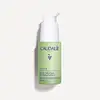Clinique Acne Solutions Clinical Clearing Gel Versus Caudalie Vinopure Blemish Control Salicylic Acid Serum
What's inside
What's inside
 Key Ingredients
Key Ingredients

 Benefits
Benefits

 Concerns
Concerns

 Ingredients Side-by-side
Ingredients Side-by-side

Water
Skin ConditioningRosa Damascena Flower Water
MaskingAlcohol
AntimicrobialNiacinamide
SmoothingTriethyl Citrate
MaskingCitric Acid
BufferingButylene Glycol
HumectantGluconolactone
Skin ConditioningSodium Citrate
BufferingPalmitoyl Grape Seed Extract
Skin ConditioningXanthan Gum
EmulsifyingSalicylic Acid
MaskingSodium Hydroxide
BufferingSodium Hyaluronate
HumectantHelianthus Annuus Seed Oil
EmollientTocopherol
AntioxidantCitral
PerfumingPelargonium Graveolens Flower Oil
MaskingMentha Piperita Oil
MaskingCymbopogon Citratus Leaf Oil
MaskingRosmarinus Officinalis Leaf Oil
MaskingCitronellol
PerfumingGeraniol
PerfumingSodium Phytate
Linalool
PerfumingLavandula Hybrida Oil
EmollientMelissa Officinalis Leaf Oil
MaskingLimonene
PerfumingWater, Rosa Damascena Flower Water, Alcohol, Niacinamide, Triethyl Citrate, Citric Acid, Butylene Glycol, Gluconolactone, Sodium Citrate, Palmitoyl Grape Seed Extract, Xanthan Gum, Salicylic Acid, Sodium Hydroxide, Sodium Hyaluronate, Helianthus Annuus Seed Oil, Tocopherol, Citral, Pelargonium Graveolens Flower Oil, Mentha Piperita Oil, Cymbopogon Citratus Leaf Oil, Rosmarinus Officinalis Leaf Oil, Citronellol, Geraniol, Sodium Phytate, Linalool, Lavandula Hybrida Oil, Melissa Officinalis Leaf Oil, Limonene
 Reviews
Reviews

Ingredients Explained
These ingredients are found in both products.
Ingredients higher up in an ingredient list are typically present in a larger amount.
Butylene Glycol (or BG) is used within cosmetic products for a few different reasons:
Overall, Butylene Glycol is a safe and well-rounded ingredient that works well with other ingredients.
Though this ingredient works well with most skin types, some people with sensitive skin may experience a reaction such as allergic rashes, closed comedones, or itchiness.
Learn more about Butylene GlycolSalicylic Acid (also known as beta hydroxy acid or BHA) is a well-known ingredient for treating skin that struggles with acne and clogged pores. It exfoliates both the skin's surface and deep within the pores to help clear out buildup, control oil, and reduce inflammation.
Unlike AHAs (alpha hydroxy acids), salicylic acid is oil-soluble. This allows it to penetrate into pores which makes it especially effective for treating blackheads and preventing future breakouts.
Salicylic acid is also known for its soothing properties. It has a similar structure to aspirin and can calm inflamed or irritated skin, making it a good option for acne-prone skin that is also sensitive.
Concentrations of 0.5-2% are recognized by the U.S. FDA as an over-the-counter topical acne product.
It can cause irritation and/or dryness if one's skin already has a compromised moisture barrier, so it's best to focus on repairing that before introducing this ingredient into your routine.
While salicylic acid does not increase sun sensitivity, it’s still important to wear sunscreen daily to protect your skin.
If you are looking for the ingredient called BHA or Butylated Hydroxyanisole, click here.
Learn more about Salicylic AcidWater. It's the most common cosmetic ingredient of all. You'll usually see it at the top of ingredient lists, meaning that it makes up the largest part of the product.
So why is it so popular? Water most often acts as a solvent - this means that it helps dissolve other ingredients into the formulation.
You'll also recognize water as that liquid we all need to stay alive. If you see this, drink a glass of water. Stay hydrated!
Learn more about Water